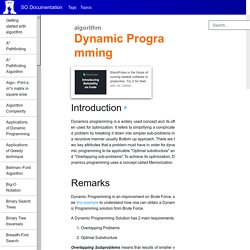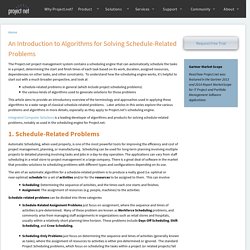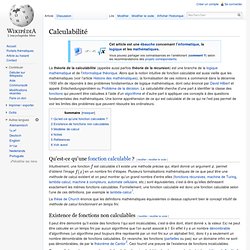

Algorithm - Dynamic Programming. Dynamics programming is a widely used concept and its often used for optimization.

It refers to simplifying a complicated problem by breaking it down into simpler sub-problems in a recursive manner usually Bottom up approach. There are two key attributes that a problem must have in order for dynamic programming to be applicable "Optimal substructure" and "Overlapping sub-problems".To achieve its optimization, Dynamics programming uses a concept called Memorization Dynamic Programming is an improvement on Brute Force, see this example to understand how one can obtain a Dynamic Programming solution from Brute Force. A Dynamic Programming Solution has 2 main requirements: Overlapping ProblemsOptimal Substructure Overlapping Subproblems means that results of smaller versions of the problem are reused multiple times in order to arrive at the solution to the original problem. Algorithmique et Programmation - Algorithmique et Programmation. Algorithme de Bellman Ford et les poids négatifs.
Youtube. Dijkstra : Entrons (un peu) dans les détails de l'algorithme. Big-O Algorithm Complexity Cheat Sheet (Know Thy Complexities!) @ericdrowell. Poster « Carte de l'informatique », par DominicWalliman. ALGORITHMES DE TRI. On désigne par "tri" l'opération consistant à ordonner un ensemble d'éléments en fonction de clés sur lesquelles est définie une relation d'ordre.

Les algorithmes de tri ont une grande importance pratique. Ils sont fondamentaux dans certains domaines, comme l'informatique de gestion où l'on tri de manière quasi-systématique des données avant de les utiliser. [PDF] Timetable scheduling using graph coloring. Design and implementation of students timetable management system. An Introduction to Algorithms for Solving Schedule-Related Problems. An Introduction to Algorithms for Solving Schedule-Related Problems The Project.net project management system contains a scheduling engine that can automatically schedule the tasks in a project, determining the start and finish times of each task based on its work, duration, assigned resources, dependencies on other tasks, and other constraints.

To understand how the scheduling engine works, it's helpful to start out with a much broader perspective, and look at schedule-related problems in general (which include project scheduling problems) the various kinds of algorithms used to generate solutions for those problems This article aims to provide an introductory overview of the terminology and approaches used in applying these algorithms to a wide range of classical schedule-related problems.
Later articles in this series explore the various problems and algorithms in more details, especially as they apply to Project.net's scheduling engine. 1. 2. 3. [PDF] Solving timetable scheduling problem using genetic algorithms. Graph Coloring Greedy Algorithm [O(V^2 + E) time complexity] Reading time: 15 minutes | Coding time: 9 minutes In graph theory, graph coloring is a special case of graph labeling ; it is an assignment of labels traditionally called "colors" to elements of a graph subject to certain constraints.
![Graph Coloring Greedy Algorithm [O(V^2 + E) time complexity]](http://cdn.pearltrees.com/s/pic/th/coloring-algorithm-complexity-223787204)
In its simplest form , it is a way of coloring the vertices of a graph such that no two adjacent vertices share the same color; this is called a vertex coloring. Similarly, an edge coloring assigns a color to each edge so that no two adjacent edges share the same color, and a face coloring of a planar graph assigns a color to each face or region so that no two faces that share a boundary have the same color. Chromatic Number: The smallest number of colors needed to color a graph G is called its chromatic number. For example, the following can be colored minimum 3 colors. Vertex coloring is the starting point of the subject, and other coloring problems can be transformed into a vertex version. Origin Pseudocode Example Implementations Complexity Applications. Exhaustive search scheduling algorithm at DuckDuckGo.
Algorithms. Preamble[edit] This book aims to be an accessible introduction into the design and analysis of efficient algorithms.

Throughout the book we will introduce only the most basic techniques and describe the rigorous mathematical methods needed to analyze them. The topics covered include: The divide and conquer technique.The use of randomization in algorithms.The general, but typically inefficient, backtracking technique.Dynamic programming as an efficient optimization for some backtracking algorithms.Greedy algorithms as an optimization of other kinds of backtracking algorithms.Hill-climbing techniques, including network flow. The goal of the book is to show you how you can methodically apply different techniques to your own algorithms to make them more efficient. This book is a tutorial on techniques and is not a reference. Table of Chapters[edit] Calcul formel.
Un article de Wikipédia, l'encyclopédie libre.

Comme exemples d'opérations de calcul formel, on peut citer le calcul de dérivées ou de primitives, la simplification d'expressions, ou encore la décomposition en facteurs irréductibles de polynômes. Historique[modifier | modifier le code] Le calcul formel a acquis une notoriété considérable depuis 1988 avec l'arrivée de Mathematica, dont le concepteur, Stephen Wolfram, a mené une campagne de publicité partout dans le monde. Cette publicité a fait mieux connaître le calcul formel dans le milieu industriel. Calculabilité. Un article de Wikipédia, l'encyclopédie libre.

Qu'est-ce qu'une fonction calculable ? [modifier | modifier le code] Intuitivement, une fonction est calculable s'il existe une méthode précise qui, étant donné un argument. Structures de données.
Graph colored. Genetic. Récursivité. Graph drawer.